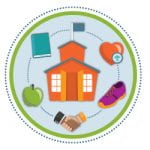
Module 3: Messages
Messages are an important tool in creating healthy schools. In fact, the right messages, shared by the right people through the right channels, can generate support and action at many different levels. As school leaders, how do you ensure that your messages have the impact you want? A method called message testing helps answer that question.
Messages matter
No matter what it is, how we talk about something — a company, a movie, a friend — it shapes the way we think about it. Words help create our reality.
If we describe a school as, for example, “a place where students are instructed in a certain curriculum and take tests to measure how much of it they’ve learned,” then our expectations for the school will be one thing.
If, on the other hand, we define a school as a place “where every aspect of student health is nurtured so that the opportunity for instruction can be maximized,” then we expect it to be something else. We expect it to be a place where the physical, social, emotional, and cognitive health of students is also part of the agenda.
Message testing for education
So messages — the words in our heads and on our lips — matter.
And here’s what also matters: Who delivers a message — the messenger — and how they deliver it — the messaging strategy.
In this module, you’ll learn about messengers, messages, and message strategies that you can rely on to generate buy-in and promote collaborative action for a healthy school. You will also learn about a process called message testing that can help you to refine the messengers, messages, and strategies you use to more effectively reach and activate specific audiences in your school or district.
“The difference between the almost right word and the right word is really a large matter — it’s the difference between the lightning bug and the lightning.”
— Mark Twain


